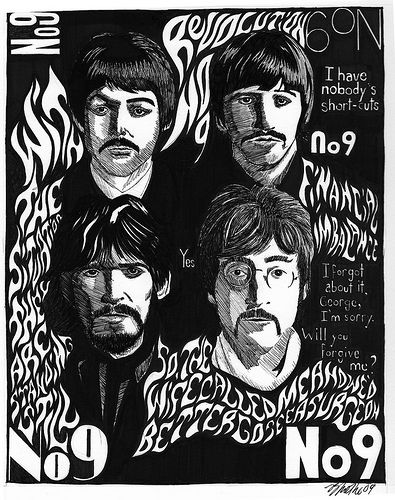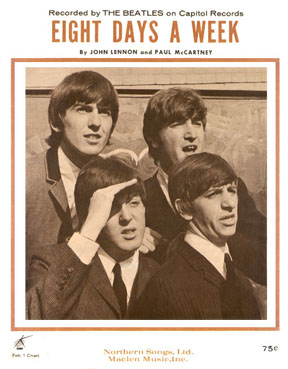35 years ago, almost on the date (November 22, 1968), the Beatles released “The White Album”. On it there is a song called “Revolution 9“. It’s a bit of a stretch to call it “a song” because all it is is a series of sound effects, mumbling, backwards tape-loops and a monotonous male voice repeating the two words: “number 9, number 9, number 9”.
A classic ode to monotony? Definitely so. But when re-interpreted from the viewpoint of linguistics and localization, the song can be viewed as a hymn to the troubles posed on us by numbers. Let me count (albeit it’s not easy) some ways in which English and Danish differ on the matters of numbers….:
1. The comma versus period dilemma:
It is generally known that Europeans and Americans use commas and periods just the opposite of each other: In U.S. the commas separate the thousands and the periods separate the decimal fraction. For example the number “ten thousand and a half” would be written:
US/Australian/UK English: 10,000.5
European: 10.000,5
There’s an interesting scientific paper describing the historical emergence of this difference between the continents. And Wikipedia has a lengthy article about the variety of ways in which the decimal points are applied around the World.
2. The ordinal:
In Danish a period is used to denominate an ordinal number. This confuses most spellcheckers because in Danish the word following the ordinal number should NOT be capitalized:
English ==> Danish
1st –> 1.
2nd –> 2.
3rd base –> 3. base
4th birthday –> 4. fødselsdag
3. Thousand millions and above are different:
It has to do with disagreements between the continents regarding the prefix “bi-“. Europe uses the “Long Scale”, where “bi-” is a multiple of a million. USA, on the other hand, uses the “Short Scale” , with “bi-” describing multiples of a thousand. This is described in great detail in this Wikipedia article. The terrible thing for most financial or scientific writers is that the words “Billion” and “Trillion” appear exactly the same in both languages, but stand for quantities that are a factor of 1000 different!:
Number ==> English ==> Danish
Million –> Million –> Million
Thousand Millions –> Billion –> Milliard
Million millions –> Trillion –> Billion
Million million millions –> Quintillion –> Trillion
So, one piece of good news is that, when translated into the Danish way of counting, the US federal deficit is only in the billions of dollars, not trillions. 🙂
4. The way we write dates:
Danish dates are separated by periods or dashes or slashes and the proper sequence is day.month.year . Also, the word “den” is used to specify a particular date (this one is really tough on any automated localization solutions). And month-names are NOT to be capitalized.
English ==> Danish
The 4th of July celebration –> 4. juli fejringen
July 4th, 1990 –> den 4. juli 1990
07/04/1990 –> 4.07.1990
from 4th to 15th of July –> 4.-15. juli
5. The way we describe time:
Americans use colon as separator between hours and seconds, Danes prefer the period. Most look-up solution for multilingual web sites can figure that one out quite easily. But then it falls apart: Predominantly Danes use the 24-hour clock. Americans generally prefer the 12 hour clock with AM and PM. The AM and PM monikers used in US with 12-hour time can not be localized in a simple manner into Danish, as Danes indeed do use the 12-hour time in everyday speech, but with FOUR (not two) descriptors: morning, before noon, afternoon and evening. Also Danish alarms do NOT go off at “6” or “7”, but at “o’clock 6” or “o’clock 7” (Danish: “klokken 7”). In other words, while in English a number mentioned in context of time is understood to mean “time”, -it is not so in Danish. Also, interestingly enough, Danish does not have a precise word for “Noon”. We have “noon-time” (Middag, middagstid), but that’s more of a meal-time description. (And to make it even more confusing the big meal of the day, which we used to eat in the midle of the day has in modern time crept up towards the evening, so when you mention “middag” to a Dane, he will most likely think that you’re talking about an evening-type dinner meal around 6 PM).
If you want to meet a Dane at High Noon, that’s simply “klokken 12” or “præcist klokken 12”. If you want to eat with a Dane around noon-time, the meal is called “Frokost” (=Lunch), NOT “Middag” or “Middagsmad”. That’s what a Dane eats around 6-7 PM.
English ==> Danish
7:00 AM –> 7.00
7:00 AM –> Klokken 7 om morgenen
7:00 PM –> 19.00
7:00 PM –> Klokken 19
7:00 PM –> Klokken 7 om aftenen
11:00 AM –> Klokken 11 om formiddagen
3:00 PM –> Klokken 3 om eftermiddagen, klokken 15.
12:00 AM –> Midnat, klokken 24
12:00 PM –> klokken 12.
(Around) noon –> Middag
Dinner –> Middag, middagsmåltid
Lunch –> Frokost
6. The way we describe price:
I have yet to see a proper English-to-Danish localization that does this correctly. Which is odd, because in most cases the incentive to localize a US web site into Danish is to SELL something to the Danes, so, one would think, that some effort would be put into displaying the price correctly. But no… Usually it’s a dead-on-arrival cause because the engineers responsible for website design (wrongly! :-)) assumed that prices are numbers, so therefore only allow numerics in their price-databases. However, they or their colleagues responsible for displaying the prices should be made aware of the fact that a correct Danish price involves the use a “dash”.
A price of 10 danish kroner and no øre (an øre is to the krone as a cent is to a dollar) should properly be shown as
10,- kroner
NOT “10 kroner” and not “10,00 kroner”.
And if possible, an øre amount should be in smaller font and superscript. See the weekly circulars below fresh from Denmark with this week’s special offers.
7. The way Danes do singles before the tens:
While fellow Scandinavian countries of Norway and Sweden have converted to pronounce a count of, say, “twenty five” as “twenty” and “five”, the Danes, like the Germans, are sticking with the reverse order: “twenty five” is “five and twenty” in Danish . Furthermore, if written with words, then the combined number is smooshed into one word: “Femogtyve” (=25). Once we get above 100 then the sequence for Danish pronunciation is “hundreds, ones, tens” (125 =ethundredefemogtyve). This may seem highly illogical for an American reader, but don’t haste to throw any rocks, because the American preference for “month-before-date” sequence for dates seems just as illogical to Danes… So there is some symmetry in trying to confuse each other 🙂
This small but significant divergence in expressing numbers between the Scandinavian countries has produced a very funny Norwegian sketch (in English of course – because THAT we all understand 🙂 ) implying that the Danes most likely don’t even understand each other.
8. The way we kind of still use base 20 for counting:
To make matters worse between the Scandinavian countries the Danish names for multiples of ten (above 40) are not, like English, Norwegian or Swedish, based on multiples of 10, but on multiples of 20! US used to be counting in 20s as well. Remember Abraham Lincoln’s Gettysburg Address?: “Four score and seven years ago our fathers brought forth on this continent, a new nation…” A “score” is 20.
English ==> Danish:
Ten –> Ti
Twenty –> Tyve
(Old English) Score (i.e. 20 pieces) –> Snes (Old Danish)
Thirty –> Tredive
Forty –> Fyrre
Fifty –> Halvtreds (roughly: “Half of the third score”)
Sixty –> Tres (roughly: “three scores”)
Seventy –> Havfjerds
Eighty –> Firs
Ninety –> Halvfems
Another Norwegian sketch, in which a Norwegian short-wave radio operator refuses to save a Danish ship sending SOS – because he can’t grasp the Danish number system, totally nails the puzzlement of fellow Scandinavians when faced with both the reverse order of numbers and the strange Danish names for powers of ten: Fleksnes makes fun of Danish Number system…. 🙂
In conclusion: In general terms I have presented here 8 ways in which the treatment of numbers in Danish differs from English. It could easily take us another “8 Days a Week” to cover the peculiar differences between Danish and English numbers in further detail. Which brings to mind another Beatles song: “Digit, digit, digit”…. Oops, it’s actually called “Dig it” 🙂







Vil bare sige dig tak for igen at give mig gode ideer til nogle lektier for den klasse canadier, som jeg underviser i dansk. Jeg kan lide den måde du skriver om emnerne. Jeg underviser frivilligt og uden betaling gennem den Skandinaviske Society of Nova Scotia for jeg er ikke lærer af profession. Sprog har bare min interesse. ,
Tak for de venlige ord. Og held og lykke med at sprede det danske sprog.